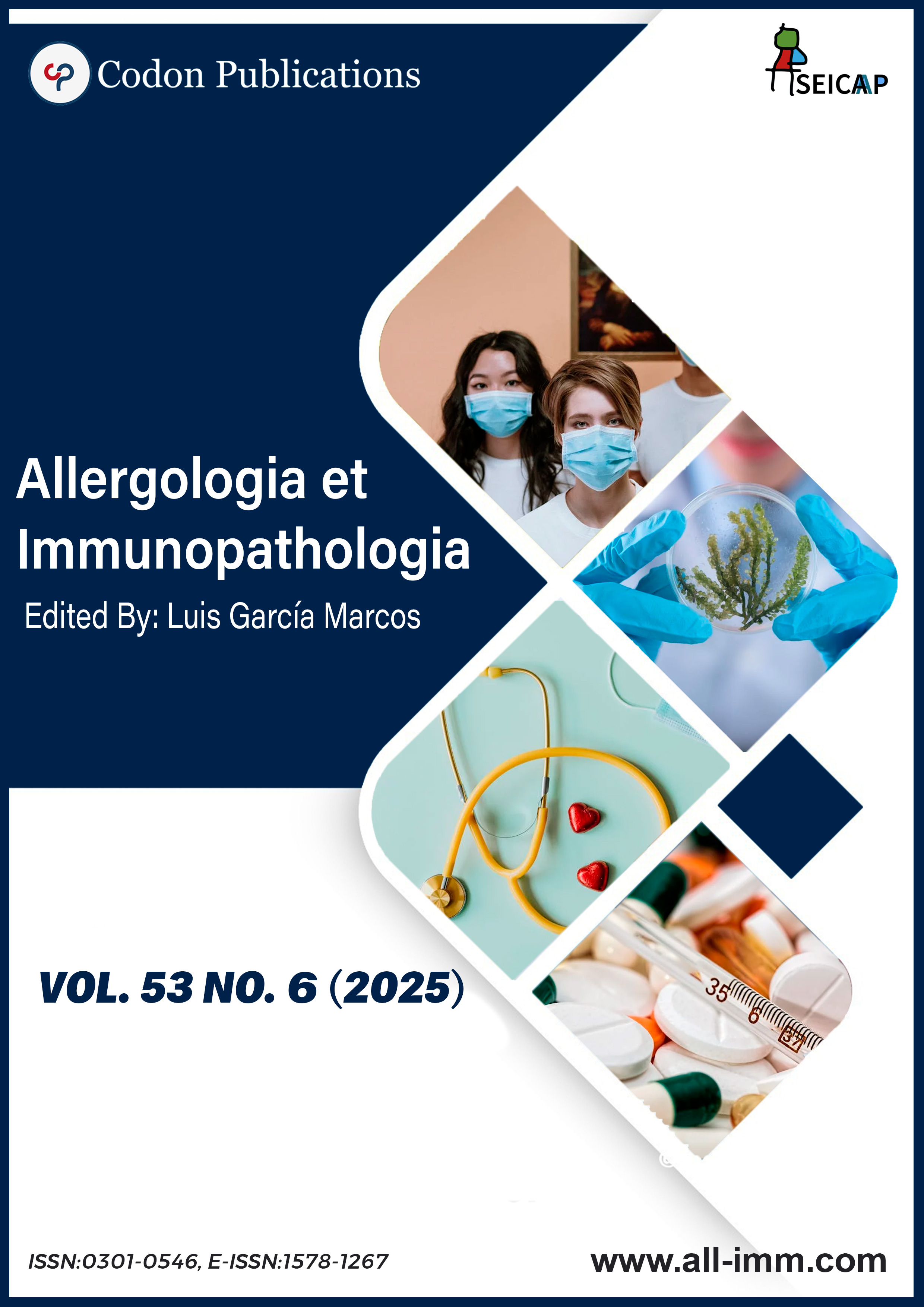Successful desensitization with FVIII/Von Willebrand Factor concentrate in Type III Von Willebrand Disease
Main Article Content
Keywords
desensitization, drug allergy, factor viii, skin test, Von Willebrand factor
Abstract
Von Willebrand Disease (VWD) Type 3 is a rare and severe bleeding disorder characterized by an almost complete deficiency of Von Willebrand Factor (VWF). Plasma-derived Factor VIII (FVIII)/VWF concentrates are used both on demand and for prophylactic treatment. However, allergic reactions to these products pose significant challenges in clinical management. A 40-year-old female patient with VWD Type 3 presented to our clinic with symptoms including jaw numbness and tightness, chills, fatigue, nausea, and dyspnea following administration of a FVIII/VWF concentrate (Haemate® P). Skin prick tests and intradermal tests were performed for diagnostic evaluation and were found to be negative. The hypersensitivity reaction was assessed as an immediate type and non-IgE-mediated reaction. As there were no alternative treatment options, we decided to perform desensitization. A 14-step desensitization protocol was successfully administered. The patient is now able to self-administer Haemate® P at home three times a week. This case highlights the importance of desensitization and multidisciplinary approach in the case of drug hypersensitivity in patients with VWD Type 3. Our desensitization protocol with FVIII/VWF concentrate is highly effective and safe.
References
2 Lenting PJ, Casari C, Christophe OD, Denis CV. von Willebrand factor: The old, the new and the unknown. J Thromb Haemost. 2012;10(12):2428–37. 10.1111/jth.12008
3 Weyand AC, Flood VH. Von Willebrand Disease: Current status of diagnosis and management. Hematol Oncol Clin North Am. 2021;35(6):1085–101. 10.1016/j.hoc.2021.07.004
4 Itzhar-Baikian N, Boisseau P, Joly B, Veyradier A. Updated overview on von Willebrand disease: Focus on the interest of genotyping. Expert Rev Hematol. 2019;12(12):1023–36. 10.1080/17474086.2019.1670638
5 van Galen KP, Mauser-Bunschoten EP, Leebeek FW. Hemophilic arthropathy in patients with von Willebrand disease. Blood Rev. 2012;26(6):261–66. 10.1016/j.blre.2012.09.002
6 Berntorp E, Petrini P. Long-term prophylaxis in von Willebrand disease. Blood Coagul Fibrinolysis. 2005;16 Suppl 1:23–26. 10.1097/01.mbc.0000167659.23262.18
7 Abshire T. The role of prophylaxis in the management of von Willebrand disease: Today and tomorrow. Thromb Res. 2009;124 Suppl 1:15–19. 10.1016/S0049-3848(09)70153
8 Platt CD, D’Angelo L, Neufeld EJ, Broyles AD. Skin testing, graded challenge, and desensitization to von Willebrand factor (VWF) products in type III von Willebrand disease (VWD). J Allergy Clin Immunol Pract. 2016;4(5):1006–08. 10.1016/j.jaip.2016.05.017
9 Beken B, Celik V, Gokmirza Ozdemir P, Eren T, Yazicioglu M. Successful desensitization of a patient with possible IgE-mediated anaphylactic reaction to FVIII/VWF concentrate. Pediatr Allergy Immunol Pulmonol. 2019;32(2):81–4. 10.1089/ped.2018.0969
10 Kaplan F, Topal E. Successful desensitization for the anaphylaxis due to F8/vWF extract in the youngest patient. Hong Kong J Pediatr Res. 2020;3(2):8–11.
11 Castells MC, Tennant NM, Sloane DE, Ida Hsu F, Barrett NA, Hong DI, et al. Hypersensitivity reactions to chemotherapy: Outcomes and safety of rapid desensitization in 413 cases. J Allergy Clin Immunol. 2008;122(3):574–80. 10.1016/j.jaci.2008.02.044
12 Muraro A, Worm M, Alviani C, Cardona V, DunnGalvin A, Garvey LH, et al. EAACI guidelines: Anaphylaxis (2021 update). Allergy. 2022;77(2):357–77. 10.1111/all.15032
13 Cardona V, Ansotegui IJ, Ebisawa M, El-Gamal Y, Rivas MF, Fineman S, et al. World allergy organization anaphylaxis guidance 2020. World Allergy Organ J. 2020;13(10):100472. 10.1016/j.waojou.2020.100472
14 Sánchez-Borges M, Ansotegui I, Cox L. World Allergy Organization Grading System for systemic allergic reactions: It is time to speak the same language when it comes to allergic reactions. Curr Treat Options Allergy. 2019;6(4):388–95. 10.1007/s40521-019-00229-8
15 Bergamaschini L, Mannucci PM, Federici AB, Coppola R, Guzzoni S, Agostoni A. Posttransfusion anaphylactic reactions in a patient with severe von Willebrand disease: Role of complement and alloantibodies to von Willebrand factor. J Lab Clin Med. 1995;125(3):348–55.
16 Lak M, Peyvandi F, Mannucci PM. Clinical manifestations and complications of childbirth and replacement therapy in 385 Iranian patients with Type 3 von Willebrand disease. Br J Haematol. 2000;111(4):1236–9. 10.1046/j.1365-2141.2000.02507.x
17 James PD, Lillicrap D, Mannucci PM. Alloantibodies in von Willebrand disease. Blood. 2013;122(5):636–40. 10.1182/blood-2012-10-46208
18 Cernadas JR, Brockow K, Romano A, Aberer W, Torres MJ, Bircher A, et al. General considerations on rapid desensitization for drug hypersensitivity—A consensus statement. Allergy. 2010;65(11):1357–66. 10.1111/j.1398-9995.2010.02441.x
19 de Las Vecillas Sánchez L, Alenazy LA, Garcia-Neuer M, Castells MC. Drug hypersensitivity and desensitizations: Mechanisms and new approaches. Int J Mol Sci. 2017;18(6):1316. 10.3390/ijms18061316
20 Sloane D, Govindarajulu U, Harrow-Mortelliti J, Barry W, Ida Hsu F, Hong D, et al. Safety, costs, and efficacy of rapid drug desensitizations to chemotherapy and monoclonal antibodies. J Allergy Clin Immunol Pract. 2016;4(3):497–504. 10.1016/j.jaip.2015.12.019

